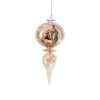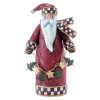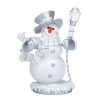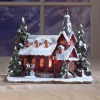You'll find Nativity Sets, Ornaments, Santa Claus, Snowmen and other beautiful Christmas
items.
A Brief History of Christmas Traditions
Christmas is filled with traditions and events, but how did they start and why do we still do them? Traditions are often passed down throughout generations for centuries, but the origins are often unknown or forgotten.
History of Celebrating Christmas
Christmas was originally called “The Feast of the Nativity of Jesus”. The word “nativity” comes from the Latin word
Natalis, meaning birthday. The observance probably does not date earlier than 200 AD and did not become widespread until the 4th century. The actual date of Jesus birth is unknown but what is known is that Christian leaders in 336 A.D. set the date to December 25 in an attempt to eclipse a popular pagan holiday in Rome. The date of Christmas coincides closely with the winter solstice in the Northern hemisphere, a time of rejoicing among many ancient cultures. Christmas, as the great popular festival of Western Europe, dates from the Middle Ages.
Santa Claus
Santa Claus was really known as St. Nicholas, he did not smoke a pipe, fly around in a wagon with any reindeer, goes down chimneys, worked with elves or live at the North Pole, he did however bring presents to children every year. According to tradition, he was born in the city of
Patara, where he became bishop of Myra. He was imprisoned during the Roman emperor Diocletian's persecution of Christians but was released under the rule of Emperor Constantine the Great. After his death he was buried in his church at Myra. In 1087, Italian sailors stole his alleged remains from Myra and took them to
Bari, Italy. Nicholas' relics remain enshrined in the 11th-century basilica of San Nicola,
Bari. Nicholas' had a reputation for generosity and kindness for the poor and unhappy. He was said to have given marriage dowries of gold to three girls whom poverty would otherwise have forced into lives of prostitution. The money was left in their stockings, which hung over the fireplace to dry. He became the patron saint of Russia and Greece. After the Reformation, Nicholas' fan disappeared in all the Protestant countries of Europe except Holland, where his legend persisted as Sinterklaas (a Dutch name, Saint Nicholas). Dutch colonists took this tradition with them to New Amsterdam (now New York City) in the American colonies in the 17th century. Sinterklaas was adopted by the country's English-speaking majority under the name Santa Claus, and his legend of a kindly old man was united with old Nordic folktales of a magician who punished naughty children and rewarded good children with presents.
The Christmas Tree
The Christmas tree is one of the most recognizable images of the season. Almost everywhere you go, it is the focal point of people's holiday decoration. You pile your gifts under the tree. You gather around your tree to sing Christmas carols. The concept of the Christmas Tree originated around 3000 B.C. in ancient Egypt. After the untimely death of King
Osiris, his wife, Isis practiced the doctrine of the reincarnation of Osiris as a spirit. She claimed a full grown evergreen tree sprang overnight from a dead stump,
symbolizing the new life of the Osiris spirit from his death. On each anniversary of Osiris birth, which was in late December, Isis would leave gifts around this tree.
One other story is when Jesus was pursued by Herod's soldiers, many plants offered them shelter. One such plant was the Pine Tree. When Mary was too weary to travel longer the family stopped at the edge of a forest to rest. A gnarled old pine which had grown hollow with its' years invited them to rest within its trunk. Then it closed its branches down and kept them safe until the soldiers had passed. Upon leaving, the Christ blessed the pine and the imprint of his little hand was left forever in the tree's fruit, the pine cone. If a cone is cut lengthwise the hand may still be seen.
Many pagan festivals used trees when honoring their gods and spirits. In Northern Europe the Vikings considered the evergreen a symbol and reminder that the darkness and cold of winter would end and the green of spring would return. The Druids of ancient England and France decorated oak trees with fruit and candles to honor their gods of harvests. At the festival Saturnalia the Romans decorated trees with trinkets and candles. The use of a Christmas tree indoors appears to have begun in Germany. German Christians would bring trees into their homes to decorate.
The tradition of the Christmas tree eventually spread through out Europe. The English Royalty help popularize the tree in England by decorating the first Christmas tree at Windsor Castle in 1841. Prince Albert, husband of Queen Victoria, decorated the first English Christmas Tree with candles, candies, fruits, and gingerbread. When the German immigrants went to American they also brought along their Christmas trees. In the 1830's most Americans still considered the Christmas tree an oddity. One of the first public displays of a Christmas tree was set up by German Settlers in Pennsylvania. At the time many still considered the tree to be a symbol of pagans and it wasn't until the late 1800's that Americans began accepting the Christmas tree.
In 1880, Woolworths first sold manufactured Christmas tree ornaments, and they caught on very quickly. Martin Luther, in the 16th century, was walking through the woods late one night. As it was clear, many stars were shining through the branches of the trees giving the impression of twinkling lights. Luther was so inspired by the beauty of the sight that he cut down a small evergreen and brought it home. He recreated the stars by putting candles on the tree's branches. The first electrically lighted Christmas tree appeared in 1882. Calvin Coolidge in 1923 ceremoniously lit the first outdoor tree at the White House, starting that long tradition.
Fruit Cake and Christmas Cookies
Many people feel that fruit cakes improve greatly with age. When they are well saturated with alcoholic liquors, which raise the spirits and keep down mold, and are buried in powdered sugar in tightly closed tins, they have been enjoyed as long as 25 years after baking.
No one knows how they got attached to Christmas. Cookies came European custom of decorating a fir tree with apples and small white wafers representing the Holy Eucharist. These wafers were later replaced by little pieces of pastry cut in the shapes of stars, angels, hearts, flowers, and bells.
Mistletoe
Mistletoe originated from the story of Balder and Frigga. Balder had a dream that he was going to die. His mother,
Frigga, the goddess of love and beauty, was frantic about his dream To ensure her son's safety, Frigga went to all of the elements, as well as to all of the animals and plants, and asked them not to kill Balder. Balder's enemy, Loki, found a loophole in Frigga's request. Mistletoe grows on the tree it attaches itself to, and therefore has no roots of its own and could not be affected by Frigga's request. Loki made a poisoned dart with mistletoe, and killed Balder. For three days, all the elements tried their hardest to bring Balder back to life, but failed. Finally, the tears that Frigga cried for her dead son changed the red mistletoe berries to white, raising Balder from the dead. Frigga then reversed mistletoe's bad reputation, and kissed everyone who walked underneath it out of gratitude for getting her son back. The correct way to use a mistletoe is for the man to remove one berry when he kisses a woman. When all the berries are gone, there is no more kissing underneath that plant. It is believed that
anunmarried woman not kissed under the mistletoe will remain single for another year.
Christmas Cards
The Christmas card began as a kind of stationery. The first card was produced by Sir Henry Cole who worked for the British Postal Service, and an artist he hired named John
Horsley. This early card was a depiction of a Christmas scene framed in three panels. In the center panel was a homey table scene: children, parents and grandparents seated and some raising their glasses for a toast. On either side were panels depicting acts of Christmas charity: to the left, feeding the hungry -- to the right, clothing the naked. Underneath appears the now familiar phrase A Merry Christmas and a Happy New Year to You. Actually cards were preceded by Christmas Pieces written by school boys in England as greetings to their parents and as proof of their progress in the art of writing.
Advent Wreaths
The Advent Wreath is a Lutheran custom that originated in Eastern Germany. They are round as a symbol of God's eternity and mercy. It is made of evergreens to symbolize God's everlastingness and our immortality. Green is also the Church's color of hope and new life. There are four candles, the three purple represent penance, sorrow, and longing expectation and one rose or pink that represents the hope and coming joy. In Denmark, the Christmas season begins on December 1, with the lighting of the calendar candle. The candle is marked with 24 lines, one for each day before Christmas -- the burning of the candle represents the waiting and preparing for Christ's coming.
12 Days of Christmas
The popular song The Twelve Days of Christmas is a song of Christian beliefs dating to the 16th century religious wars in England, with hidden references to the basic teachings of the faith. Each present represents a biblical term. On
Http://www.debwebonline.com/Mercy_in_Jesus/twelvedays.html there is a list of the 12 symbols with their meanings:
1 Partridge in a pear tree = The One true God revealed in the person of Jesus Christ
2 Turtle Doves = The Old and New Testaments
3 French Hens = Faith, Hope and Charity
4 Calling Birds = the Four Gospels and/or the Four Evangelists
5 Golden Rings = The first Five Books of the Old Testament, the Pentateuch which contain the law condemning us of our sins.
6 Geese A-laying = the six days of creation
7 Swans A-swimming = the seven gifts of the Holy Spirit, the seven sacraments of the Catholic faith
8 Maids A-milking = the eight beatitudes
9 Ladies Dancing = the nine Fruits of the Spirit
10 Lords A-leaping = the ten commandments
11 Pipers Piping = the eleven faithful apostles
12 Drummers Drumming = the twelve points of doctrine in the Apostle's Creed
Christmas Cane
A candy-maker in Indiana wanted to make a candy that would be a witness, so he made the Christmas Candy Cane. He incorporated several symbols from the birth, ministry, and death of Jesus Christ. He began with a stick of pure white, hard candy. White to symbolize the Virgin Birth and the sinless nature of Jesus, and hard to symbolize the Solid Rock, the foundation of the Church, and firmness of the promises of God. The
candy-maker made the candy in the form of a J to represent the precious name of Jesus, who came to earth as our Savior. It could also represent the staff of the Good Shepherd. Thinking that the candy was somewhat plain, the
candy-maker stained it with red stripes. He used three small stripes to show the stripes of the scourging Jesus received by which we are healed. The large red stripe was for the blood shed by Christ on the cross so that we could have the promise of eternal life.
Christmas Gifts
In ancient Rome, people exchanged gifts on New Years' Day. These might be jewelry, pieces of gold and silver, or home-made pastry, cookies and candies. Sweet things were given to ensure sweetness for the year to come, lamps to wish for the light and warmth, and money was given to wish for increasing wealth. Wrapping of gifts may have originated in Denmark. When the Apostles brought the Gospel to Rome, the people learned of the Three Wise Men who came from the Orient to present gifts to the newborn King. From then on, the old custom was only slightly changed. The exchanging of presents remained, but now it was done in imitation of the three wise men, on Christmas.
We are proud to be able to deliver our merchandise to the following
US States Nationwide:
Alabama, Alaska, Arizona, Arkansas, California, Colorado, Connecticut,
Delaware, District of Columbia, Florida, Georgia, Hawaii, Idaho, Illinois,
Indiana, Iowa, Kansas, Kentucky, Louisiana, Maine, Maryland, Massachusetts,
Michigan, Minnesota, Mississippi, Missouri, Montana, Nebraska, Nevada, New
Hampshire, New Jersey, New Mexico, New York, North Carolina, North Dakota,
Ohio, Oklahoma, Oregon, Pennsylvania, Rhode Island, South Carolina, South
Dakota, Tennessee, Texas, Utah, Vermont, Virginia, Washington, Washington
D.C., West Virginia, Wisconsin, Wyoming.
www.SNEDCO.com - SNEDCO
Wholesale Gifts and Home Decor
Free Drop Shipping - Best Buys
Wholesale - Discount Shopping - Money Back Guarantee
No Gimmicks - No Membership Fees - No Sign-ups - No
Minimum Orders!
Copyright © www.snedco.com
SNEDCO Wholesale. All Rights Reserved.

Christmas and Holiday accessories for all to love!














